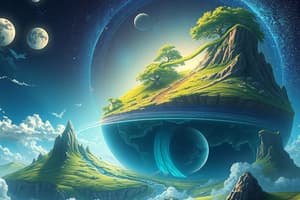Podcast
Questions and Answers
What is the Earth described as in terms of its age?
What is the Earth described as in terms of its age?
4.56 billion years old
Which of the following is true about the Earth's revolution around the Sun?
Which of the following is true about the Earth's revolution around the Sun?
- It does not rely on the Sun
- It revolves in a circular path
- It occurs twice a year
- It takes approximately 365-366 days (correct)
Earth is the only planet to harbor life.
Earth is the only planet to harbor life.
True (A)
What is the study of the Earth's characteristic behavior called?
What is the study of the Earth's characteristic behavior called?
Name the four main subsystems of the Earth.
Name the four main subsystems of the Earth.
What is the primary component of Earth's atmosphere?
What is the primary component of Earth's atmosphere?
Which layer of the atmosphere contains the ozone layer?
Which layer of the atmosphere contains the ozone layer?
The thermosphere is where meteor burns occur.
The thermosphere is where meteor burns occur.
The process in which water vapor cools down to form clouds is called ______.
The process in which water vapor cools down to form clouds is called ______.
What are the stages of the water cycle?
What are the stages of the water cycle?
What is the driving agent of the hydrological cycle?
What is the driving agent of the hydrological cycle?
Match the type of precipitation to its description:
Match the type of precipitation to its description:
What is the process by which groundwater is replenished?
What is the process by which groundwater is replenished?
What is the lithosphere?
What is the lithosphere?
What are tectonic plates?
What are tectonic plates?
Study Notes
Earth Overview
- Third planet from the Sun, approximately 4.56 billion years old based on radiometric dating.
- Completes an orbit around the Sun every 365-366 days.
- Unique as the only planet known to support life, located in the "Goldilocks Zone."
Earth's Subsystems
-
Atmosphere: A layer of gases held by Earth's gravity, containing 78% nitrogen, 20.95% oxygen, 0.93% argon, and 0.04% other gases.
- Key layers include:
- Troposphere: Where weather occurs and life exists.
- Stratosphere: Contains the ozone layer, protecting Earth from harmful UV rays.
- Mesosphere: Where meteors burn up upon entry.
- Thermosphere: Region where satellites orbit.
- Exosphere: Transition zone to outer space.
- Key layers include:
-
Hydrosphere: The liquid component of Earth, covering 70% of the surface, predominantly saltwater (98%).
- Plays a crucial role in regulating atmospheric conditions.
Hydrological Cycle (Water Cycle)
- Continuous movement of water between the Earth's surface and atmosphere, driven by solar energy.
- Involves energy transfer through phases: evaporation, condensation, precipitation, and infiltration.
Water Cycle Processes
- Evaporation: Conversion of liquid water to vapor, primarily powered by solar energy.
- Transpiration: Water movement in plants where water is absorbed and evaporated from leaves.
- Condensation: Cooling of water vapor into liquid, forming clouds.
- Precipitation: Release of water from clouds, essential for delivering atmospheric water to Earth's surface as rain, snow, or hail.
Types of Precipitation
- Rain: Liquid droplets delivering freshwater.
- Snow: Solid precipitation occurring at temperatures below 0°C, formed as ice crystals.
- Hail: Irregular balls of ice forming during thunderstorms, varying in size from 5mm to 15cm.
Infiltration
- Process where precipitation is absorbed by soil, moving into rocks, and replenishing groundwater supplies.
Geosphere
- Represents Earth's solid state, including structures such as rocks and minerals.
- Lithosphere: Solid outermost layer of the geosphere containing tectonic plates.
- Tectonic Plates: Large rocky segments of the lithosphere that move and interact with each other, influencing Earth's geological activity.
Studying That Suits You
Use AI to generate personalized quizzes and flashcards to suit your learning preferences.
Related Documents
Description
In this creative activity, students will draw Earth and label its various subsystems. Each subsystem must be accompanied by a brief description that explains its significance and role. This exercise encourages understanding of Earth's composition and the interconnectedness of its systems.




